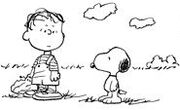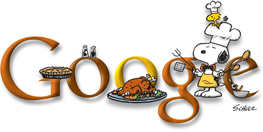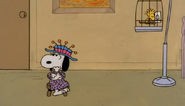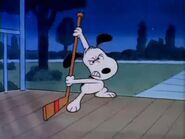(Undo revision 30839 by BradSnoopy97 (talk)The page looked better before.) |
(→External links: Portuguese interwiki.) |
||
| Line 95: | Line 95: | ||
[[de:Snoopy]] |
[[de:Snoopy]] |
||
[[es:Snoopy]] |
[[es:Snoopy]] |
||
| + | [[pt:Snoopy]] |
||
[[Category:Snoopy| ]] |
[[Category:Snoopy| ]] |
||
Revision as of 11:52, 4 September 2014
"Snoopy’s whole personality is a little bittersweet. But he’s a very strong character. He can win or lose, be a disaster, a hero, or anything, and yet it all works out. I like the fact that when he’s in real trouble, he can retreat into a fantasy and thereby escape."
Charles M. Schulz on Snoopy
Snoopy is one of the main protagonists of the Peanuts comic strip by Charles M. Schulz. He is very well known, even more well known than Charlie Brown, and may be among the most recognizable comic characters in the world. He is Charlie Brown's pet beagle, and is owned and cared for by Charlie Brown, although at times it is not clear who is in charge. Snoopy is blessed with a rich, Walter Mitty-like fantasy life.
In most of the Peanuts television specials, Snoopy is voiced by Bill Melendez. Andy Beall voiced Snoopy in Happiness is a Warm Blanket, Charlie Brown, taking over the role after Melendez's death in 2008.
Background
Snoopy first appeared in the October 4, 1950 strip, two days after the strip began. Schulz originally planned to call him "Sniffy", but found out that name was used in a different comic strip. He then changed the dog's name to Snoopy. The name first appeared on November 10, 1950.
Peanuts comic strip from February 2, 1951.
In the early days, it was unclear who was the owner of Snoopy. It was not necessarily Charlie Brown. For instance, in the strip from February 2, 1951, Charlie Brown yells at Snoopy for following him, until Patty tells him that Snoopy is not following him, but simply lives in the same direction. Other early strips show Snoopy on a leash with Shermy or Patty, and not Charlie Brown. However, other early strips Snoopy in Charlie Brown's room at night, as he is going to sleep. It seems that in the early days of the strip, Snoopy was an ownerless dog who played with the various children. As the years went by, Snoopy began to interact with Charlie Brown more often than the other children. It is eventually shown that Snoopy's doghouse is in Charlie Brown's backyard, and Charlie Brown is responsible for feeding him. It is eventually confirmed that Charlie Brown is the owner, when he says that his parents bought Snoopy for him, when he was upset, after a boy dumped a bucket of sand on him in a sandbox.
Snoopy has some little bird friends, the most loyal of which is Woodstock. Snoopy also has seven siblings, Spike, Belle, Marbles, Olaf, Andy, and two others named in the special Snoopy's Reunion as Molly and Rover . The eight puppies were born at the Daisy Hill Puppy Farm. Snoopy has recalled his family going to the Daisy Hill Puppy Farm's chapel every day, and being part of a fifty-beagle choir. He also taught Sunday school there, a fact Charlie Brown sometimes forgets. He went to school at the Ace Obedience School.
Snoopy loves root beer and pizza, hates coconut candy, gets claustrophobia in tall weeds, and is deathly afraid of icicles dangling over his doghouse. One of his hobbies is reading Leo Tolstoy's epic novel War and Peace at the rate of "a word a day". Snoopy also has the uncanny ability to play fetch with soap bubbles, and can hear someone eating marshmallows or cookies at a distance, or even peeling a banana. He claims to hear chocolate chip cookies calling him. Snoopy is also capable of disappearing, like the Cheshire Cat from Alice in Wonderland, as shown in an extended strip, whenever Charlie Brown reads the book to him. ("Grins are easy. Noses are hard. Ears are almost impossible."). Two things Snoopy dislikes are listening to balloons being squeezed and cats.
Linus tells Charlie Brown about Snoopy's first owner Lila in the strip from August 30, 1968.
According to a series of comic strips from August 1968 and the movie, Snoopy Come Home, at an early age, Snoopy was taken in by a girl named Lila, but when she was unable to keep him, he was returned to the farm, where Charlie Brown picked him up. This fact came to light when Lila was in the hospital and wrote to Snoopy, asking him to come and visit her. Linus did some research and learned of this, sharing his information with Charlie Brown when Snoopy returned.
Snoopy appears to like Charlie Brown. Once when Charlie Brown came home from camp, Snoopy made a welcome home banner and was waiting outside Charlie Brown's house with cake. However, the banner said "Welcome home, Round-headed Kid." Snoopy often referred to Charlie Brown as "the Round-Headed Kid" not out of spite, but simply because he could not remember his name.
According to a series of strips in from August 7 to August 10, 1968, Snoopy's birthday is August 10.
Personality
Snoopy is a genuinely happy dog. A running gag within the strip is that he does a "happy dance", which annoys Lucy because she believes that nobody can ever be that happy. However, Snoopy just thinks Lucy is jealous because she is not capable of being as happy as he is. The only thing that upsets him is a lack of supper. Snoopy, being a dog, has a strong hatred of cats, often making rude remarks to the cat next door (Who usually attacks him and destroys his doghouse) and in one series of strips wrote stories in a magazine which basically just pointed out that cats were stupider and inferior to dogs. However, Snoopy has on occasion tried to be nice to the cat next door, but their relationship always remains antagonistic.
Snoopy also loves sleeping, and being lazy - a trait which often annoys Frieda. Snoopy often lies on top of his doghouse and sleeps, sometimes all day long. In one strip, Charlie Brown refers to him as a "hunting dog", because he always hunts for the easy way out of life.
In later strips, Snoopy's main human contact (when not indulging in his fantasy life) is with Rerun van Pelt.

Rerun van Pelt and Snoopy
Younger than the other children, Rerun deals with his loneliness and lack of owning a dog by persistently asking to borrow Snoopy from Charlie Brown. Snoopy alternates between refusing to leave the house and agreeing to play with Rerun on his own terms (such as having Rerun push him on a stroller or pull him on a sled). While he also shows genuine affection for Rerun, Snoopy sometimes reacts indignantly to being treated as a common dog. In one strip, Rerun calls him a "puppy dog" while playing with a stick. After seeing Snoopy drop the stick off a cliff, he declares, "I am not a puppy dog."
Development
The first appearance of Snoopy in the Peanuts comic strip from October 4, 1950.
In the very early years of Peanuts, Snoopy behaved much like an average, everyday pet. Gradually, however, he became more like a human than a dog. Snoopy was a silent character during the first two years in the strip, but he eventually verbalized his thoughts to readers for the first time (in a thought balloon) on May 27, 1952.
Schulz once said that the best idea he ever had in the strip was to move Snoopy from inside his doghouse to the rooftop. Preceding that, there was a gradual evolution of the character - from something much like an actual, real-life dog to an anthropomorphic character, resembling that of typical cartoon animals.
Snoopy plays baseball in the Sunday strip from April 6, 1952.
On April 12, 1957, Snoopy first appeared as the shortstop on Charlie Brown's baseball team, although he has appeared playing baseball since April 6, 1952. The idea of the baseball team being so bad that one of its players was a dog was a long running gag in the comic strip.
On June 28, 1957, Snoopy walked on his two hind legs for the first time. This soon became so commonplace as to be almost unnoticeable. As the strip progressed, Snoopy becomes a much more human-like dog. His character is that of a dog who thinks he is a person (or who sometimes forgets he is a dog). In one strip, Sally has to do a report on animals for school, and requests Snoopy's help. But Snoopy was reluctant: "How can I help? I don't know any animals."
Fantasy life
See main article: List of Snoopy's alter egos
Snoopy imitates a bird in the strip from August 9, 1951.
Snoopy has a very broad and vivid fantasy life, often delving into many alter egos.
Snoopy has done many impressions over the years. His earliest impression (that of a bird) was seen on August 9, 1951. Starting on November 17, 1955, his impressions really began to take center stage: He did impressions of Violet, a pelican, Lucy, a moose, Beethoven and Mickey Mouse. He would also pretend to be other animals, including a snake, rhinoceros, lion, and vulture. But his eccentricities did not stop there.
Snoopy first appears as the World War I Flying Ace in the Sunday strip from October 10, 1965.
The most famous of his alter egos is The World War I Flying Ace. When assuming this personality, Snoopy dons goggles, a flying helmet and a scarf, and climbs on top of his doghouse (which he claims is a Sopwith Camel). His enemy the Red Baron, like other adult figures in Peanuts, never appears in the strip; his presence being indicated through cues like the bullet holes that riddle the doghouse, and Snoopy's fist-shaking and cries of "Curse you Red Baron" while his Sopwith Camel doghouse plummets to earth trailing smoke.
Another well-known persona is "Joe Cool", which Snoopy becomes by putting on sunglasses and leaning against a wall doing nothing.
Snoopy has also been a famous writer, a bow tie-wearing attorney (who once defended Peter Rabbit), a hockey player, an Olympic figure skater (who used to skate with Peggy Fleming before he became "big time"), and even a world famous grocery checkout clerk who operated from the top of his doghouse in an apron. He also appeared as an astronaut, claiming to be the first beagle on the moon.
Snoopy in other media

Snoopy and Woodstock featured in the Google logo for Thanksgiving 2009.
Over the years, Snoopy has become the mascot of several different companies.
- Following the Apollo I fire, Snoopy became the official mascot of aerospace safety, testing and the rebuilding of the Apollo Program, due to his refusal to accept defeat and his "'outside the doghouse' way of looking at things." A series of Snoopy-in-Space ("Astrobeagle") products arrived with this campaign, and originals are still prized.
- The Apollo 10 lunar module was nicknamed "Snoopy" and the command module "Charlie Brown". While not included in the official mission logo, Charlie Brown and Snoopy became semi-official mascots for the mission.
- The Silver Snoopy award is a special NASA honor, in the form of a sterling silver pin with an engraving of Snoopy in a spacesuit helmet. It is given by an astronaut to someone who works in the space program that has gone above and beyond in pursuit of quality and safety.
- A series of postage stamps featuring Snoopy as a World War I flying ace was released on May 17, 2001 in Santa Rosa, California.
- Snoopy, piloting his "Sopwith Camel" (i.e., his doghouse), is featured in the logo of Charles M. Schulz - Sonoma County Airport.
- Snoopy is the US Air Force Communications - Computer Systems Control mascot. He can be seen on the Tech Control emblem holding an old analog patch cord above his head as he walks on water.
- During the Gulf War Snoopy appeared as nose art on several aircraft. He remains a popular image in air forces that still allow crews to customize the appearance of their planes.
- Snoopy is the name of a U.S. Air Force B-58 Hustler bomber, serial number 55-0665, which was modified to test a radar system.
- Snoopy, Lucy, Peppermint Patty, Sally Brown and Marcie appeared in Japanese hot pepper commercials.
- Snoopy and Woodstock were featured in an At commercial.
- Snoopy is the name of the primary research vehicle of Check-Six.com. *The black-and-white communications caps (formally called a Communications Carrier Assembly) worn as part of NASA spacesuits, carrying radio earphones and microphones, are universally known as "Snoopy caps", due to the resemblance of the white center and black outer sections to the top of Snoopy's head.
- In 1966, the "Ace" was immortalized in song by The Royal Guardsmen with their hit, "Snoopy Vs. The Red Baron". This was followed in 1967 by "The Return of the Red Baron", in which it is revealed that the Baron survived their previous encounter but runs away when Snoopy challenges him to a duel with pistols, and then by "Snoopy's Christmas", in which the two foes temporarily set aside their differences for a Christmas toast, as per the Christmas Truces that occurred during World War I. "Snoopy's Christmas" continues to be played as a holiday favorite on many oldies radio stations. During the 1968 U.S. Presidential election, the Guardsmen released two additional songs, "Snoopy for President", in which Snoopy's bid for the nomination of the Beagle party is tipped in his favor by the Red Baron, and "Down Behind the Lines", which does not mention Snoopy specifically but describes the attempts of a World War I pilot to fly his damaged Sopwith Camel back to friendly territory. In 2006 the Guardsmen recorded a song called "Snoopy vs. Osama" in which Snoopy shifts his focus away from The Red Baron and captures Osama Bin Laden.
- American insurance company MetLife has used Snoopy as their corporate mascot since the 1980s. Snoopy One, Snoopy Two and Snoopy Three are three airships owned and operated by MetLife that provide aerial coverage of American sporting events, and feature Snoopy as the World War I flying ace on their fuselage.









